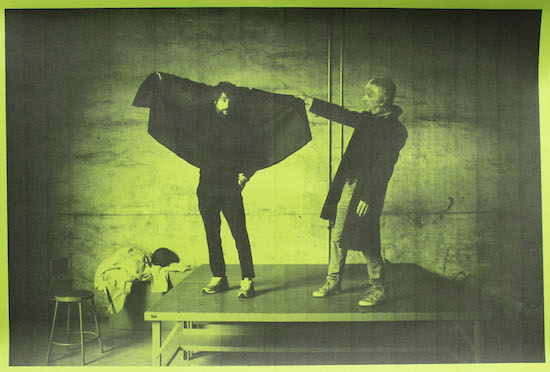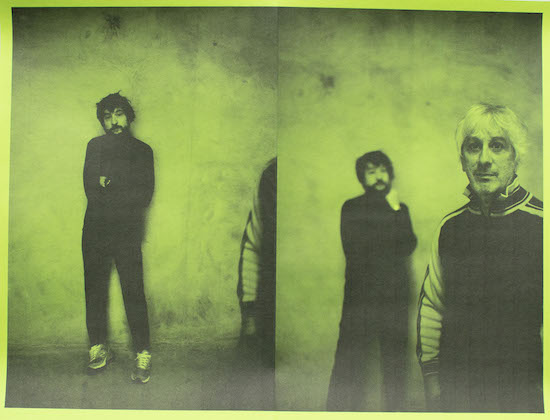Band portraits by Ari Marcopoulos
With regards to mention of the Coronavirus, this interview took place a fortnight ago, Ed
A few days before speaking to tQ, Lee Ranaldo received an email confirming what he already feared. The US government had revoked his Global Entry Status. The 64-year-old musician knew what to expect a week earlier when he re-entered his native country via the international airport in Newark. The customs officials there informed him, "Oh, if you lived in New Jersey, you’d still have your status. Because you live in New York, you’re having your status pulled away."
"It’s just another incident in our fucked-up government right now," Ranaldo explains with weary exasperation. "Trump is recalling or denying all of those people’s status from certain cities in the US that he’s trying to punish." The Global Entry Status approves people who travel frequently, such as touring musicians like Ranaldo and Patti Smith who has also had it withdrawn for the same misdemeanour of living in New York, from having to queue up with everybody else, have their bags checked, and all that palaver. You have to be interviewed before approval is granted, get fingerprinted, fill out the necessary documents, etc. Once accepted, travellers can then waltz through the automated kiosks when entering the US at select airports.
"It’s a convenience more than anything else," notes Ranaldo. "It’s a privilege, I guess, but you pay for it and they check you out thoroughly to make sure they think you’re a safe person, and then you don’t have to wait on these lines or go through customs or anything. Trump recently rescinded it for people in what he called ‘sanctuary cities’ – New York, Los Angeles – places where he thinks they have ports of entry that are harbouring illegal immigrants. He’s decided to punish the local people by making it harder for them to get through the borders, let alone what happens to the immigrants who come through."
No wonder Ranaldo is dismayed. The globetrotting guitarist’s first international tour took place back in 1981 when he was part of Glenn Branca’s Ascension band. A couple of years later, Sonic Youth set sail for their first of many European tours. Ranaldo has established friendships with people all over the world from touring with Sonic Youth, as well as with his various solo projects and other artistic collaborations. Trump’s jingoistic MAGA attitude also jars with the international nature of Ranaldo’s latest record, Names Of North End Women, recorded in partnership with the Spaniard Raül Refree. The latter’s own work ranges from – and often blends the boundaries between – music based in flamenco to more abstract electronic and sample-based material such as the set he performed at 2018’s Sonar Festival.
"The lines that separate genres in music make me feel the same as those lines that are drawn on the maps to separate countries," Refree has said in the past: "They don’t make sense." He elaborates on this philosophy with me now, via Skype, a couple of days before I speak to Ranaldo. "With traditional music, I find that it has a special emotion that touches me because I think it’s something we have in our genomes or genetics; something that’s been with us for centuries." Also widely travelled, Refree found that although determinate forms of flamenco (for example) will have a deeply rooted presence in certain regions, as soon as you start to move around and begin to understand other local forms of music, it is possible to chart a gradation across regions, countries and the world. It is not a case of "Okay, that only happens here; this other music only happens here," he insists. "There are so many things in common. It really is like a journey.
"The lines that we draw on maps are not like a big hole and then there’s something completely new after that. It’s all one thing and it’s difficult for me to understand music divided. I can’t divide music. The only line I can draw is if I can like it or not. To draw a line between genres is almost impossible."
In their separate conversations, Ranaldo and Refree both pinpoint the breakthrough moment that occurred as soon as it was decided that this was going to be a fully fledged duo project, rather than another Lee Ranaldo solo album with Refree’s name listed in the production credits. "From that moment on, we really felt free to try anything," remembers Refree who had worked with Ranaldo before and now found himself as one half of a bona fide musical partnership. "We were not tied to anything. We were trying not to be tied to our past. We just tried to do what we really felt that we had to do." At first, he recalls, the two musicians didn’t even know exactly what it was they were working on. Was it an album? A single? An EP? Something that could conceivably be replicated live… or perhaps not? They weren’t entirely sure.
Neither party remembers making any conscious or predetermined decision to move away from what might be deemed the recognisable and traditional traits of rock music. The evolution occurred more naturally than that. Refree speaks with passion about searching for new spaces within the music, of experimenting with electronic textures, and how this fitted nicely with Ranaldo’s substantial use of spoken word (some of the lyrics provided by author Jonathan Lethem) and the process of combining modern digital recording techniques with creating loops out of physical cassette tape, not something Refree had tried before.
"I think our idea of working together, especially now that we’ve put both of our names on the cover as a collaborative duo, is that we are free to experiment and we can take those experiments wherever we want," confirms Ranaldo. "And in this case, we made a record that does not feature the guitar as the first or the primary instrument. We used the guitar in the same way we used the other instruments we were using. We used it where we thought it was needed, and we wanted to keep the whole thing very sparse so we didn’t slather instruments all over it. These days when you hear a ‘rock’ record, the guitar starts at the beginning of the first song and doesn’t end until the end of the last song, in a sense. We just wanted to break that habit and use things more specifically."
Ranaldo also mentions that they were listening to, discussing and drawing inspiration from "long-form" sources and other things from outside the rock canon, "whether it was abstract or minimal, or modern or a little bit older". The examples he cites include Steve Reich’s Music For 18 Musicians, pieces by Ryuichi Sakamoto, the electronic music of Arca, the vocal sounds of Meredith Monk, and Haley Fohr who records as Circuit des Yeux and appears on Names Of North End Women‘s ‘The Art Of Losing’. Cellist Joan Antoni Pich and two members of The Sey Sisters also feature on the record. Unlike his contributor-heavy 2017 album Electric Trim though, this time Ranaldo was keen to pare things back:
"We felt like the last record was really dense and each song had a lot of different sections to it. For this record, we wanted to almost strip both of those things away. We wanted it to be more open and atmospheric. We wanted to build songs out of simpler sections and not pack in five or ten different changed sections into each song. I like that kind of ‘theme and variation’ thing so I write like that a lot. For this record, we stripped down a lot of those points. It wasn’t like when we started we said, ‘Let’s not make a rock record.’ It just seemed to be that everything we were interested in was moving us in that direction. I don’t think we even thought about it much or realised it, until we had the group of songs going well, that this was not a rock record. It was something different. It dealt with landscape."

Along with using guitar (sparingly, when it felt necessary), they also used gamelans, marimbas and vibraphones. The individual instruments’ sounds are not always clearly identifiable, mind, seeing as the pair also got into looping, sampling, distorting and manipulating the sounds they were making. The gamelans were left over from Ranaldo’s Sonic Youth days, having been brought back by the band when they visited Indonesia in the 90s. If there is any Sonic Youth album that could feasibly be likened to Names Of North End Women, then it might have to be NYC Ghosts & Flowers from the year 2000. It is not the most well-known or widely praised record in the art rock heroes’ discography, although the 0.0 rating it was given by Pitchfork is now worn by the band as a badge of pride, the snide score having unintentionally provided the album with a certain gravitas and notoriety. Heavy on the spoken word and featuring dashings of electronics, NYC Ghosts & Flowers was recorded after a bunch of the band’s equipment had been stolen.
"Huh. Well. That’s interesting," says Ranaldo when considering the parallels. "I can see your point. I can see the relationship with that record. For Sonic Youth, that was a strange record. It wasn’t a super popular record in its time, although all those songs worked really well and found their footing as live pieces. We made that record before we played any of that material live. In some regard, that record was examining the New York beat literature and poetry scene of the 40s, 50s and 60s; the circle around people like Allen Ginsberg and Ted Berrigan and people like that. It was a departure for us in terms of the way we put that record together and the way we approached those songs. So, in a way, for Sonic Youth that record was stretching what we were up to at that moment in time. In that regard, I can see the similarity.
"I think with that record, in the same vein [as Names Of North End Women], we weren’t really trying to make a rock record. We were trying to make a record that supported this interest that we were mining at that moment, of this period of New York before we arrived, basically. We knew about it and we knew about many of the characters that came out of that period, but it still had this kind of mythic presence to us and we wanted to speak a little bit about that. So we weren’t really concerned about making rock songs so much as making these sort of sound pieces. We had recently made Goodbye 20th Century, where we were concentrating on and doing pieces by John Cage and Yoko Ono [among others] that had come out of that same 50s/60s period. People didn’t understand it at the time. They thought, ‘What’s Sonic Youth up to here?’ They had a certain expectation of what we were at that moment, and we subverted it to some degree. Maybe that’s the similarity with this record. For myself and Raül, this is a record that subverts expectations of a lot of different people who might know one or another aspect of his work or my work."
Since Sonic Youth announced their split in 2001, each ex-member’s subsequent output has been fascinating to follow. It’s been noticeable, however, that the band’s alumni really seem to have upped the ante over just the last few months. First came Thurston Moore’s Spirit Counsel. Split across three compact discs, each one housing a single lengthy composition, this instrumental opus harked back to Moore’s apprenticeship under Glenn Branca and mooted his role as the heir apparent. Then of course there was Kim Gordon’s sprightly No Home Record. Unlike, say, Sleater Kinney’s embracement of synthesisers that was handled so cringingly it caused their drummer to quit, Gordon’s electronic direction was as thrilling as when Liars graduated from their origins as jerky post-punk no-wavers to trading in wonky dystopian disco bangers, or perhaps that time Mark E. Smith hooked up with Mouse On Mars for Von Südenfed’s thumping Tromatic Reflexxions.
"I felt the same thing as I heard each of their records," Ranaldo enthuses, "that we were each, at this point in our career (or however you want to call it), pushing forward into new territory at almost the same time, which is completely interesting to me. I thought that was like a feather in Sonic Youth’s cap, in a way, that that’s happening right now." Ranaldo can’t fully explain what caused this synchronicity to happen but he knows that when he and Refree cemented their partnership, the concept was always to push forward into fresh sonic territory. Ranaldo remembers discussing this plan with his old pal Thurston Moore when they met for drinks in New York a year or so ago: "We were sitting across the table from each other and Thurston said something like, ‘You know, I’ve been feeling the same thing right now, that I want to do something very different than I’ve done before.’ I don’t know if it was in the air or we’re just that deep into our careers where either we have nothing to lose or we’re just ready to try something new. I’m very proud of the fact that all three of us have these new and different-reaching records out within, like, three or four months of each other."
There is a short pause as Ranaldo concocts a scheme in his head and then blurts out an idea that, were it to come to fruition, would have every Sonic Youth fan riddled in goosebumps and reaching straight for their wallets: "Now the package tour! Right? Wouldn’t that be something? Steve [Shelley] drumming for each act! Haha!"
Just like Spirit Counsel and No Home Record, Names Of North End Women feels like quite the revelation. With its emphasis on texture, timbre and space, its creators delving into more open-ended ambience rather than hooking everything around pre-written demos, rich vocals that alternate between speaking and singing, and the light clanking and other intriguing and often unidentifiable noises that whirr away in the background, Names Of North End Women might well appeal to fans of one of Ranaldo’s all-time favourite bands: Einstürzende Neubauten. It’s not so much the German band’s belligerent early material that comes to mind (and that everybody talks about all the time), but rather their equally impressive later work that has had a gentler, more mature and delicate feel.
"I love every period of their career," says Ranaldo. "I’ve seen them bowl me over in the early days and I’ve seen later performances that were just as powerful. They’re not a name I’ve been dropping about this record but maybe they are one that I should be, because their music has always been about blocks of sound, whether it was done with electrical grinders or hammers on metal sheets or later when they approached it in some more sophisticated ways. Or less dangerous ways, I guess. Their music has always been built out of sound blocks in a very contemporary or modernist way. I think that’s a lot of what we did with this record. It was made in the studio. For as great a band as they are live, they really knew how to work in a studio because they were creating atmospheres and that was what we wanted to do with this record. We wanted it to be really atmospheric and be sound-oriented, so we were almost working in a sense like sound collages."
Both Ranaldo and Refree are excited about the prospect – and the challenge – of taking these songs (or "sound collages") that they built up carefully, meticulously and sensitively in the studio and working out what to do with them onstage. They flirted with the idea of roping in a cellist, bassist and drummer. In the end, it was decided that performing as a duo would be more consistent with the experimental nature of the record itself. Refree says that he keeps live performances completely away from his mind when he’s in the studio, or else the creative process will become restricted. When he attends other people’s concerts, Refree prefers not to be confronted with an exact replication of the album that he has already heard at home. Instead, the duo have been working on how to lift the songs on Names Of North End Women to another level. They’ve been looking for new ways to play them and considering how to unearth fresh spaces within each composition. There are going to be homemade instruments onstage alongside Lee’s vintage cassette machines, and plenty of improvisation will be undertaken. There may be older songs in the set as well, and maybe even a classic Steve Reich piece. In sticking with the retreat from rock music, Ranaldo speaks of this as more of a "listening event" than a gig.
But that is only going to come to fruition if the duo are even able to head out on the road in the first place. "It’s kind of interesting, this coronavirus thing," observes Ranaldo, "because even though maybe it started within the political boundaries of China, it’s suddenly a global epidemic that basically isn’t going to go away unless governments work together to fight it in ways that they are not normally accustomed to. It’s going to be curious to see how it plays out, in a way, because it’s beyond politics at this point. It’s a pandemic. It’s going to be interesting to see if people work together on it or not. It could be like The Middle Ages, you know? It could be like The Black Death and wipe out a quarter of the population of the world or something. There’s a lot of good science-fiction fodder in our current times."
Names Of North End Women is out now on Mute Records. Ranaldo & Refree are supposed to be touring Europe in early April but at this rate who can be certain about anything anymore?




